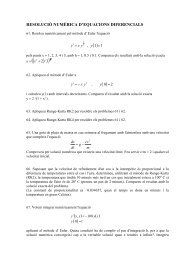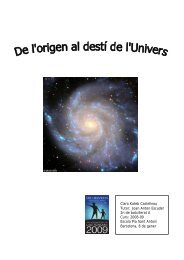Universitat de - Departament d'Astronomia i Meteorologia ...
Universitat de - Departament d'Astronomia i Meteorologia ...
Universitat de - Departament d'Astronomia i Meteorologia ...
You also want an ePaper? Increase the reach of your titles
YUMPU automatically turns print PDFs into web optimized ePapers that Google loves.
2.6. The X-ray counterpart: RX J1826.2−1450 73<br />
On the other hand, the multicolor disk mo<strong>de</strong>l, although formally fitting the data,<br />
does not help either. First, given the low luminosity (LX < 10 35 erg s −1 in the energy<br />
range 2–10 keV) the system would be in the so-called low/hard state. We would<br />
not expect then to <strong>de</strong>tect a strong soft component. Second, the fit provi<strong>de</strong>s an<br />
unrealistic value of the disk internal radius of Rin cos 1/2 (θ) ∼ 0.3 km.<br />
Unfortunately, the source is too faint at energies above 30 keV to be <strong>de</strong>tected<br />
with the HEXTE/RXTE instrument. Thus, we cannot confirm from the present<br />
data whether the hard tail that usually characterizes the energy spectrum of black<br />
holes at high energies is in<strong>de</strong>ed present.<br />
2.6.3 BeppoSAX observations<br />
With the aim to confirm and improve the obtained results after the PCA/RXTE<br />
observations, we observed 22 RX J1826.2−1450 / LS 5039 with the BeppoSAX X-<br />
ray satellite during ∼ 80 ksec on 2000 October 8 (MJD 51825.29–51826.21). Un-<br />
fortunately, while the flux <strong>de</strong>tected during the PCA/RXTE observations was of<br />
∼ 5 × 10 −11 erg s −1 cm −2 , it was only of ∼ 5 × 10 −12 erg s −1 cm −2 during the<br />
BeppoSAX observations, i.e., one or<strong>de</strong>r of magnitu<strong>de</strong> lower. Hence, we could not<br />
confirm the <strong>de</strong>tection of the ∼ 6.7 keV iron line due to lack of signal-to-noise ra-<br />
tio. However, we could improve the value of the hydrogen column <strong>de</strong>nsity, NH =<br />
1.0 ± 0.3 × 10 22 cm −2 , and obtain a new value of the photon in<strong>de</strong>x, Γ = 1.8 ± 0.2 (in<br />
the energy range 3–10 keV).<br />
Using the relation by Pre<strong>de</strong>hl & Schmitt (1995) the NH value implies E(B−V ) =<br />
1.9±0.6, nearly compatible with the E(B−V ) 1.2±0.1 values <strong>de</strong>rived from optical<br />
photometry (see Table 2.6) and much higher than the E(B − V ) 0.4 +0.2<br />
−0.4 value<br />
<strong>de</strong>rived from the PCA/RXTE observations, which was poorly constrained. On the<br />
other hand, the value of Γ is compatible with the one found in the PCA/RXTE<br />
observations, and typical of black holes in the low/hard state, although we note<br />
that McSwain & Gies (2002) have recently suggested a neutron star nature for the<br />
compact object in LS 5039.<br />
The BeppoSAX observations took place in JD 2451825.79–2451826.71, hence<br />
very close to the T =JD 2451822.12 value used in the McSwain et al. (2001)<br />
22 Reig, P., Ribó, M., Pare<strong>de</strong>s, J. M., & Martí, J. 2002, in preparation.






